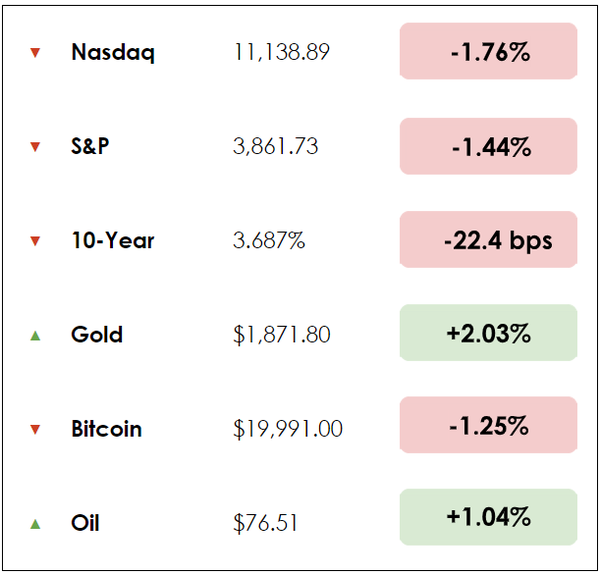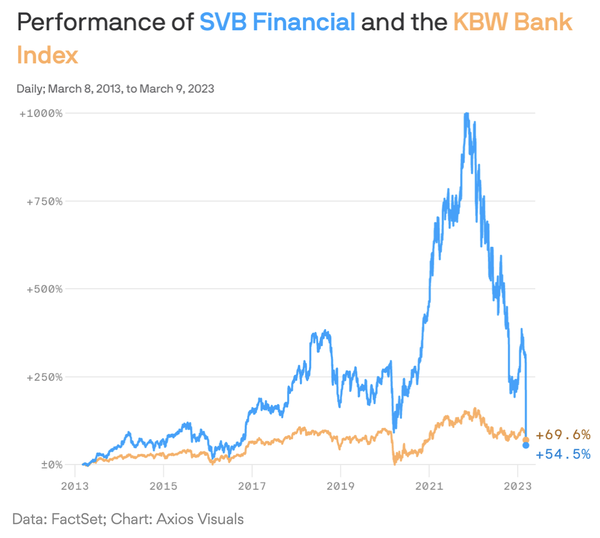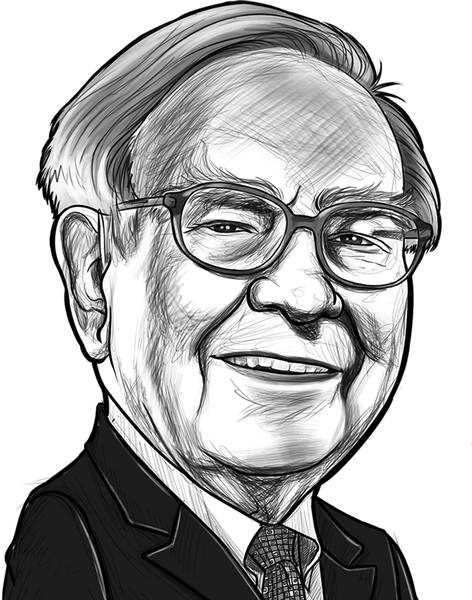Major FOMO

Hi, The Investor’s Podcast Network Community!
Yikes. It was a rough week for stocks, as the S&P 500 just registered its worst week since September.
The benchmark is now down about 6% in the past month and only up 1% YTD, while Bitcoin fell more than 11% on the week as investors continue to be spooked by inflation, yields, and Jerome Powell’s hawkish rhetoric.
Meanwhile, Treasury yields are falling sharply as investors move to safer assets such as government bonds.
Oh, and Silicon Valley Bank collapsed Friday in the second-biggest bank failure in U.S. history 😱
More on that drama below.
Here’s the rundown:
MARKETS
*All prices as of market close at 4pm EST
Today, we’ll discuss two items in the news:
- Today’s bank collapse triggers 2008 flashbacks
- What actually happened at SVB and what it means
- Plus, our main story on the fear of missing out (FOMO)
All this, and more, in just 5 minutes to read.
Get smarter about valuing businesses in just a few minutes each week.
Get the weekly email that makes understanding intrinsic value
easy and enjoyable, for free.
IN THE NEWS
🚨 Silicon Valley Bank Fails, Triggering 2008 Flashbacks (Bloomberg)
Explained:
- SVB Financial Group, the parent company of Silicon Valley Bank (SVB), is in talks to sell itself after efforts to raise capital amid a bank run failed. Its stock fell 60% on Thursday, only to plunge another 63% in early trading Friday before trading was halted.
- Despite insisting for months that it wouldn’t restructure its balance sheet, SVB stunned investors when it announced Wednesday an emergency issuance of shares, hoping to raise $2.25 billion before booking a $1.8 billion loss on its bond portfolio.
- SVB is the biggest bank failure since the 2008 financial crisis after its long-established customer base of tech startups grew worried and yanked deposits. Now, the Federal Deposit Insurance Corp. (FDIC) is working with California state regulators, which took possession of the bank on Friday, to sort out the mess.
Why it matters:
- “The company has said that it does business with almost half of all U.S. venture capital-backed startups,” according to Bloomberg. Things went wrong as the Federal Reserve’s aggressive rate hiking campaign to combat inflation dampened venture capital funding, drying up the bank’s deposit base while firms spent down their cash balances.
- This all comes just a few days after another bank, Silvergate Capital, known for its connections to crypto firms, announced that it was voluntarily liquidating assets and ceasing operations.
- Observers have long said the Fed is likely to “hike until something breaks,” and it certainly feels like something big just broke. Investors are once again betting that the Fed will be forced to pivot and begin cutting rates again to support the economy/financial system this year, which could jeopardize its efforts to tame inflation.
⚠️ Going Deeper Into SVB’s Collapse (WSJ)
Explained:
- Silicon Valley Bank (SVB) is the 16th largest bank in the U.S., with some $209 billion in assets. While it raced to find buyers willing to inject new money towards saving it, regulators weren’t willing to wait.
- The California Department of Financial Protection and Innovation promptly closed the bank. At the same time, the Federal Deposit Insurance Corp. (FDIC) transferred all of the bank’s deposits to a new entity called the Deposit Insurance National Bank of Santa Clara.
- The FDIC, which generally covers deposits up to $250,00 per depositor, has said that insured depositors will have access to their funds by Monday morning. In contrast, uninsured depositors will get a receivership certificate for the remaining uninsured funds. Receivership typically means that another bank will take over the troubled bank’s deposits, or the FDIC will pay depositors up to the insured limit.
- Bankers at Goldman Sachs had arranged for SVB to issue shares at $95 a piece and raise capital as of Thursday afternoon, but the deal fell apart as the bank run worsened.
Why it matters:
- From a 30,000-foot-view, banks work by borrowing short-term, cheap funds — primarily from depositors — and then investing that capital over longer periods at higher rates. As the venture capital boom has slowed, so have SVB’s deposits dried up. But the firm’s problems extend beyond just a connection to the venture capital industry.
- Since the Fed began raising rates, SVB’s portfolio of bonds — filled with securities purchased when bond prices were near their peak during the pandemic — has suffered considerable losses (bond prices and interest rates have an inverse relationship).
- While it’s too early to say with full confidence, this is probably not as bad as the financial contagion we saw in 2008. Many other banks face similar situations, though, where their bond holdings purchased over the last decade have lost considerable value, given the increase in interest rates this past year.
Real estate investing, made simple.
17% historical returns*
Minimums as low as $5k.
EquityMultiple helps investors easily diversify beyond stocks and bonds, and build wealth through streamlined CRE investing.
*Past performance doesn’t guarantee future results. Visit equitymultiple.com for full disclosures
WHAT ELSE WE’RE INTO
📺 WATCH: Four insights from Buffett’s latest letter
👂 LISTEN: Insights from a reclusive investment firm
📖 READ: Psychological paths of least resistance
Overview
Many of us have been there: A friend or colleague cashes in on a nice trade, and we feel the urge to make a similar move.
At its core, that’s really all FOMO, or the fear of missing out, boils down to. Resisting FOMO can be a superpower in investing.
Here’s author Morgan Housel: “Few things matter more with money than understanding your own time horizon and not being persuaded by the actions and behaviors of people playing different games than you are.”
What is FOMO?
When you see a friend making good money on short-term options, you might get FOMO and want to emulate them. But if you have a 10-year time horizon and would rather buy and hold quality companies over the long haul, it might not be wise to start playing your friend’s game.
In a recent blog post, Housel noted that Dwight Eisenhower used to quote Napoleon, who said a military genius is “the man who can do the average thing when everyone else around him is losing his mind.”
Similarly, Charlie Munger once said:
“Someone will always be getting richer faster than you. This is not a tragedy… The idea of caring that someone is making money faster than you are is one of the deadly sins.”
In 2020 and 2021, FOMO investing might have peaked as meme and high-growth stocks flourished. Investors piled into them, yet many fell on the losing end of the trade as prices fell sharply in 2022.
“That fear of missing out on things makes you miss out on everything,” said Dutch author Etty Hillesum.
Roots of FOMO
A big rally could trigger FOMO, which might be manifested in anxiety, fear, or stress.
Other triggers include Twitter, financial news, meme stocks, and investing forums.
Researchers have cited that mitigating FOMO starts with awareness. They advise sticking to your plan, which is cliché but difficult to put into practice amid euphoria at (or near) market peaks.
Know that someone else will always be making more money than you. It’s not depressing; it’s freeing.
Said Warren Buffett: “You must also resist the temptation to stray from your guidelines.”
Buffett on FOMO
FOMO also relates to spending: feeling the need to match the neighbor’s car or buy the latest gadget to “keep up” with others.
Research has found FOMO to be more prominent in people age 18-35, cryptocurrency investors, and among people who use social media every day.
Researchers also have found FOMO impacts quality of life, leading to anxiety, loss of money, disconnection from family, and even depression.
FOMO is a buzzword that has taken on new meaning in the last few years amid the rise of investing among young people. Social media has exacerbated the trend.
Many investors might feel behind, but sticking to your principles, setting social media or news limitations, and practicing gratitude for what you do have all been proven to mitigate the fear of missing out.
Simply, not being susceptible to FOMO can be an advantage. Here’s Buffett in his 2000 letter to shareholders:
“The line separating investment and speculation, which is never bright and clear, becomes blurred still further when most market participants have recently enjoyed triumphs. Nothing sedates rationality like large doses of effortless money.
He continues:
“After a heady experience of that kind, normally sensible people drift into behavior akin to that of Cinderella at the ball. They know that overstaying the festivities– that is, continuing to speculate in companies that have gigantic valuations relative to the cash they are likely to generate in the future – will eventually bring on pumpkins and mice.
“But they nevertheless hate to miss a single minute of what is one helluva party. Therefore, the giddy participants all plan to leave just seconds before midnight. There’s a problem, though: They are dancing in a room in which the clocks have no hands.”
Dive deeper
Morgan Housel’s The Psychology of Money discusses FOMO and the never-enough fallacy. And here’s Buffet’s full 2000 letter.
RECOMMENDED READING
Life-Changing Concepts newsletter makes you more successful in life with mental models.
Get a summary of 20 useful mental models when you join.
SEE YOU NEXT TIME!
That’s it for today on We Study Markets!
See you later!
If you enjoyed the newsletter, keep an eye on your inbox for them on weekdays around 6pm EST, and if you have any feedback or topics you’d like us to discuss, simply respond to this email.
















